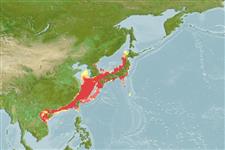أشلاق (القروش و الشفانين) (sharks and rays) >
Myliobatiformes (Stingrays) >
Myliobatidae (Eagle and manta rays)
Etymology: Myliobatis: Greek, mylo = mill + Greek, + Greek, batis,-idos = a ray (Raja sp.) (Ref. 45335).
Eponymy: This is not an eponym but based on a Japanese name; from tobi, the Japanese name for the Black Kite (Milvus migrans) and jei for ray, so literally translating as ‘kite(-like) ray’. (Ref. 128868), visit book page.
More on author: Bleeker.
Environment: milieu / climate zone / depth range / distribution range
البيئة
بحري القاع; نطاق العمق 0 - 220 m (Ref. 9862). Tropical
Northwest Pacific: central China to Russia (Sea of Okhotsk).
Length at first maturity / الحجم / وزن / العمر
Maturity: Lm ?, range 65 - ? cm
Max length : 150 cm TL ذكر/ مختلط الجنس; (Ref. 9862)
A common inshore and offshore species, demersal in intertidal habitats to depths of at east 220 m (Ref.58048). Found from the intertidal to the uppermost continental slope (Ref. 9862, 11230). A carnivore feeding on benthic animals. Ovoviviparous (Ref. 50449). Caught occasionally by inshore, demersal longline fisheries. Utilized for its meat and cartilage (Ref.58048).
Life cycle and mating behavior
النضج | التكاثر | وضع البيض | بيض | الخصوبة | Larvae
Exhibit ovoviparity (aplacental viviparity), with embryos feeding initially on yolk, then receiving additional nourishment from the mother by indirect absorption of uterine fluid enriched with mucus, fat or protein through specialised structures (Ref. 50449).
Masuda, H. and G.R. Allen, 1993. Meeresfische der Welt - Groß-Indopazifische Region. Tetra Verlag, Herrenteich, Melle. 528 p. (Ref. 9137)
IUCN Red List Status (Ref. 130435: Version 2024-1)
خطر للأنسان
Traumatogenic
استخدامات بشرية
مصائد: غير مهمة تجارياً; لعبة سمكه: نعم
أدوات
تقارير خاصة
Download XML
مصادر علي الأنترنت
Estimates based on models
Preferred temperature (Ref.
123201): 12.8 - 24.7, mean 20.3 °C (based on 176 cells).
Phylogenetic diversity index (Ref.
82804): PD
50 = 0.5002 [Uniqueness, from 0.5 = low to 2.0 = high].
Bayesian length-weight: a=0.00389 (0.00119 - 0.01269), b=3.08 (2.83 - 3.33), in cm total length, based on LWR estimates for this (Sub)family-body shape (Ref.
93245).
مستوى غذائي (Ref.
69278): 3.5 ±0.37 se; based on food items.
المرونه (Ref.
120179): منخفض, الحد الزمني الأدني لتضاعف عدد أفراد المجتمع 4.5-14 سنة (Fec assumed to be <100).
Fishing Vulnerability (Ref.
59153): Very high vulnerability (90 of 100).
